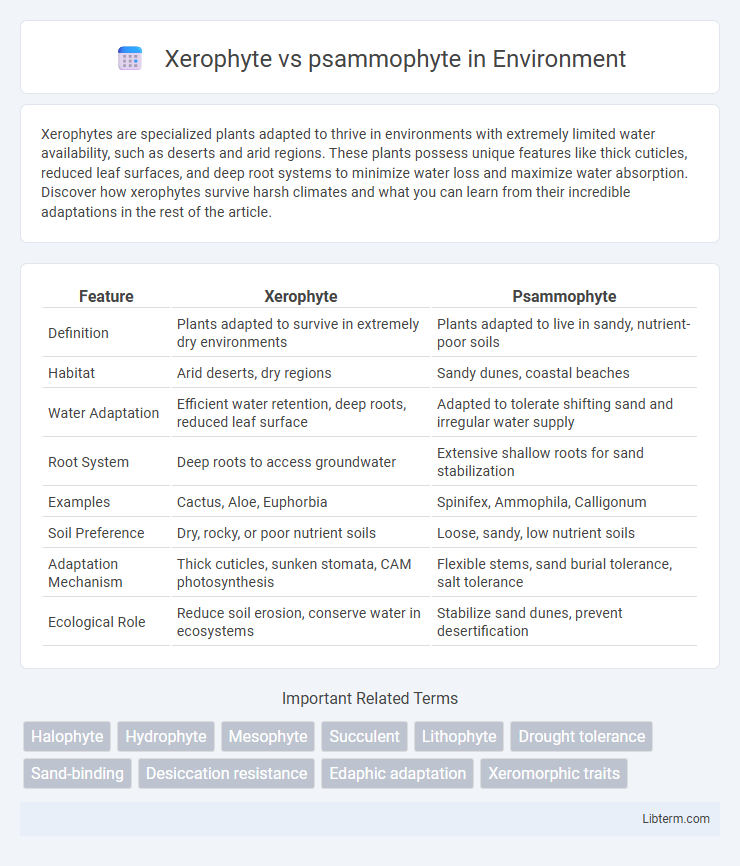Xerophytes are specialized plants adapted to thrive in environments with extremely limited water availability, such as deserts and arid regions. These plants possess unique features like thick cuticles, reduced leaf surfaces, and deep root systems to minimize water loss and maximize water absorption. Discover how xerophytes survive harsh climates and what you can learn from their incredible adaptations in the rest of the article.
Table of Comparison
| Feature | Xerophyte | Psammophyte |
|---|---|---|
| Definition | Plants adapted to survive in extremely dry environments | Plants adapted to live in sandy, nutrient-poor soils |
| Habitat | Arid deserts, dry regions | Sandy dunes, coastal beaches |
| Water Adaptation | Efficient water retention, deep roots, reduced leaf surface | Adapted to tolerate shifting sand and irregular water supply |
| Root System | Deep roots to access groundwater | Extensive shallow roots for sand stabilization |
| Examples | Cactus, Aloe, Euphorbia | Spinifex, Ammophila, Calligonum |
| Soil Preference | Dry, rocky, or poor nutrient soils | Loose, sandy, low nutrient soils |
| Adaptation Mechanism | Thick cuticles, sunken stomata, CAM photosynthesis | Flexible stems, sand burial tolerance, salt tolerance |
| Ecological Role | Reduce soil erosion, conserve water in ecosystems | Stabilize sand dunes, prevent desertification |
Introduction to Xerophytes and Psammophytes
Xerophytes are plants adapted to survive in environments with minimal water availability, featuring specialized structures such as thick cuticles, sunken stomata, and water storage tissues to minimize water loss. Psammophytes thrive in sandy soils, often in coastal or desert regions, exhibiting traits like extensive root systems and tolerance to high soil permeability and nutrient scarcity. Both plant types demonstrate unique adaptations critical for survival in harsh, water-limited habitats, highlighting ecological diversity in arid and sandy ecosystems.
Defining Xerophytes: Key Characteristics
Xerophytes are plants adapted to survive in environments with minimal water availability, characterized by thick, waxy cuticles, reduced leaf surface area, and deep root systems to enhance water retention and uptake. These adaptations enable xerophytes to minimize transpiration and endure prolonged drought conditions typical of arid deserts and semi-arid regions. In contrast, psammophytes specifically thrive in sandy soils, often exhibiting traits like extensive root networks for soil stabilization and nutrient absorption in loose, shifting substrates.
Psammophytes Explained: Unique Adaptations
Psammophytes are specialized plants adapted to thrive in sandy environments characterized by low water retention and nutrient scarcity. Their unique adaptations include deep root systems for anchoring and accessing deep moisture, extensive leaf modifications to reduce water loss, and the ability to tolerate high salt and temperature fluctuations. These traits distinguish psammophytes from xerophytes, which primarily adapt to arid conditions but do not necessarily specialize in sandy substrates.
Habitat Differences: Where Xerophytes and Psammophytes Thrive
Xerophytes thrive in arid and semi-arid environments characterized by low rainfall and extreme temperature fluctuations, such as deserts and dry rocky areas. Psammophytes are specialized plants adapted to sandy habitats, including coastal dunes and desert sand dunes, where soil drainage is rapid and nutrient availability is low. Both plant types exhibit unique adaptations to survive in their distinct harsh habitats, with xerophytes focusing on water conservation and psammophytes emphasizing root stability and sand tolerance.
Morphological Adaptations in Xerophytes
Xerophytes exhibit morphological adaptations such as thick, waxy cuticles, reduced leaf surface area, and sunken stomata to minimize water loss in arid environments. These plants often develop deep root systems to access underground water sources and may have succulent tissues for water storage. In contrast, psammophytes primarily adapt to sandy soil conditions with extensive root networks to stabilize loose substrates and tolerate nutrient-poor soils.
Adaptive Features of Psammophytes
Psammophytes exhibit specialized adaptive features such as deep root systems for accessing underground water, thick cuticles to reduce water loss, and the ability to tolerate high salt concentrations commonly found in sandy, coastal soils. Their leaves often have reduced surface area or are covered with trichomes to minimize transpiration, enhancing survival in nutrient-poor, dry environments. These adaptations enable psammophytes to thrive in shifting sand dunes and arid habitats characterized by low water availability and high temperature fluctuations.
Physiological Strategies for Survival
Xerophytes exhibit physiological adaptations such as CAM photosynthesis and reduced stomatal density to minimize water loss in arid environments. Psammophytes optimize water uptake through extensive root systems and osmotic adjustments to cope with saline, sandy soils. Both plant types enhance cellular water retention by accumulating compatible solutes like proline and betaines for drought and salt stress tolerance.
Ecological Roles of Xerophytes and Psammophytes
Xerophytes play a crucial ecological role in arid and semi-arid environments by stabilizing soil and reducing erosion through their deep root systems and water-conserving adaptations. Psammophytes, specialized in sandy habitats, contribute to dune stabilization and nutrient cycling, enabling the establishment of other plant species in nutrient-poor, shifting sands. Both plant types enhance biodiversity and ecosystem resilience by adapting to extreme conditions where few other species can survive.
Examples of Xerophyte and Psammophyte Species
Xerophytes like cacti (Genus: *Carnegiea*), agave (*Agave americana*), and aloe (*Aloe vera*) thrive in arid ecosystems with adaptations such as thick cuticles and reduced leaf surfaces to minimize water loss. Psammophytes, including species like *Ammophila arenaria* (European beach grass), *Calligonum* spp., and *Ipomoea pes-caprae* (beach morning glory), specialize in sandy, shifting soil habitats, stabilizing dunes with extensive root systems. Both plant groups exhibit unique physiological and structural traits to survive extreme environmental conditions, highlighting biodiversity adaptations in xeric and psammic landscapes.
Xerophyte vs Psammophyte: Comparative Summary
Xerophytes and psammophytes are specialized plants adapted to extreme environments, with xerophytes thriving in arid, drought-prone regions by minimizing water loss through thick cuticles and reduced leaf surface area. Psammophytes are adapted to sandy, nutrient-poor soils with high drainage, exhibiting deep root systems and the ability to stabilize shifting sands. The key distinction lies in habitat specificity: xerophytes withstand general water scarcity, while psammophytes excel in sandy, often coastal or desert dune habitats.
Xerophyte Infographic

 libterm.com
libterm.com